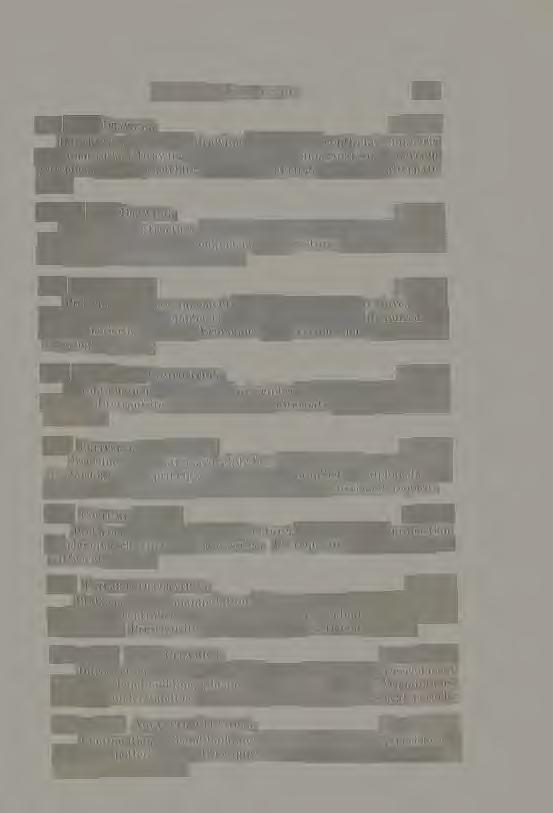
22 minute read
Music
COURSES OF INSTRUCTION 103
111. BASIC DRAWING. 2 hours
Introduction to various drawing media with continual emphasis upon composition. Drawing from memory and imagination to develop perception. Outdoor sketching in fall and spring. Offered in alternate years.
211-212. LIFE DRAWING. 4 hours
The study of structure and form of the h1llnan figure. Rapid sketch from the model with emphasis upon gesture. Offered in alternate years. Not offered in 1960-61.
121. BASIC DESIGN. 2 hours
Problems in the arrangement of line, mass, space, texture, value and color with special emphasis on the nature of color. Required for students majoring in Home Economics and recommended for students majoring in Speech.
224. DESIGN AND COMPOSITION. 2 hours
A continuation of the use of principles of design and the nature of color. Prerequisite: 121. Offered in alternate years. Not offered in 1960-61.

226. LETTERING AND LAYOUT. 2 hours
Learning to use standard alphabets and to create new ones. Understanding basic p1'inciples of design as applied to alphabets and layout. Skill in using pen and bTush. Offered on sufficient request.
231. COSTUME DESIGN. 2 hours
Problems in the use of colo1·, texture, line, value and proportion in planning clothing and accessories. Prerequisite: 121. Offered on sufficient demand.
232. INTERIOR DECORATION. 2 hours
Problems in the manipulation of mass, space, texture and color as they are controlled by the needs of the individual and the family in the home. Prerequisite: 121. Offered on sufficient demand.
233 or 234. BASIC CERAMICS. 2 or 9 hours
Introduction to the use of clay as an ai-t medium. Development of skill in hand-building, glazing and in filing a kiln. Acquaintance with and understanding of ceramics from various historical periods.
333 or 334. AnVA 'CED CERAMICS. 2 or 3 houn
Continuation of hand-building, glazing and firing. Experience in using the potter's wheel. Prerequisites: 121 and 233 01· 234. Offered together with 233 or 234.
10-t
OTTF.1U3EI. · C0LLEGe
2:i5 or 236. DESIGN IN MATERIALS. !! OT 8 hours
Application of principles of design in three-dimensional problems. Exploration of creative design possibilities of various materials: wood, metal, plastics, etc. Prerequisite: 121 or the permission (If the instructor. Offered in alternate years.
241 or 242. WATERCOLOR PAlNTlNG. f hours
Exploration of various technique. and expei-imentation with color relationships in picture composition. Prerequisite: some courses in drawing nnd design or the permission of the instructor. Offered in alternate years.
341 or 342. ADVANCED WATERCOLOR PAINTING. f hours
Offered together with 241 or 242 which is a prerequisite.
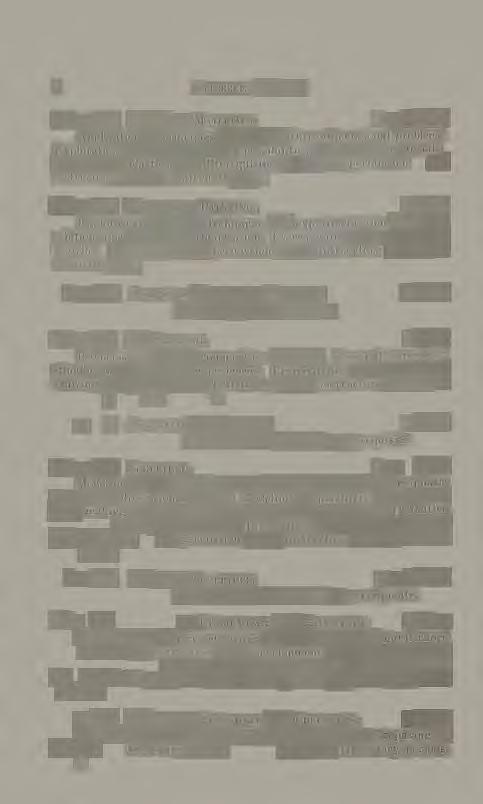
2f,1 or 252. OIL PAINTING. f hours
Problems of picture composition in color. Personal expression stimulated by aesthetic experiences. Prerequisite: some courses in rlrawing and design or the permission of the instructor. Off~red in alt ·m te yc!ar1:. , • ot offer d :in l!l60-Gl.

:151 01' ;3r,2. Au\·A:-.CED OIL PAINTING. 2 hours
Otfor·c<l together with 251 or 252 which is a pr~requisite.
2til or 262. SCULPTURE. f or 3 hours
Modeling of the figure, animals and the abstract with emphasis upon three dimensional design. Modeling in plastilene and ceramic clay, making molds, casting in plaster and ceramic clay. Creative cXp,·ession in the plastic medium. Prerequisite: some courses in drawing nnd design or the permission of the instructor. Offered in aJter1.ate years.
H l or :JG2. ADYA. 'CED SCULPTURE. _ or 9 hours
Otr r 0 d together with 2Gl or 2C2 which is a prerequisite.
2 I or 282. METuoos I • ELBME. 'TARY ART EDUCATION. 9 hours
The study of the characteristics of child art and the significance of the child's art expression to his development as a creative individual. Experience in arts and crafts related to their use in the elemental'y school art program. Two 2 hour periods per week with additional outside work.
3 3 or 384. Mi,;-moos l:'.'I SECONDARY ART EDUCATION. 8 hour,
A methods course for those art students who are preparing to teach in the secondary school. Weekly class and laboratory periods. C:i ·en upon reque~t.
391 or 392. SPECL\L PROBLEMS IN ART. 1-5 lwurs f Re~a_l'ch projects in art history, appreciation, or creative work or qualified students. Permission of the instructor. lt!ay be repeated not to exceed 5 hours. Laboratory fee to be adjusted .
. 'JOI. Ff1 T08Y OF ARCHITE<::rune. 3 hour.~
A study of tl1e appreciation of architecture and its clu·onological development in Western civilization. Th.ree classes each week. Course fee $2.00. Offered in alternate years. Not offered in 1960-61.
302 · HISTORY OF PAINTING A:,JO SCULPTURE. 3 hour,; to A th e general survey of painting and sculpture from paleolithic tirn~s Present. Three classes each week. Course fee $2.00. Offered in alternate years. Not offered in 1960-61.
:io3 or 304. H!~"TORY OF l\Iovmx PAINTI. ·a. :, hOIUS 8nd A study of works of major artists and movements of the 19th 20th centuries to develop an u'nderstanding of the work of the !>resent. Thl'ee th · e instructor. classes each week Course fee · · Given upon sufficient request. $2.00. Permission of
HUl\IANITIES
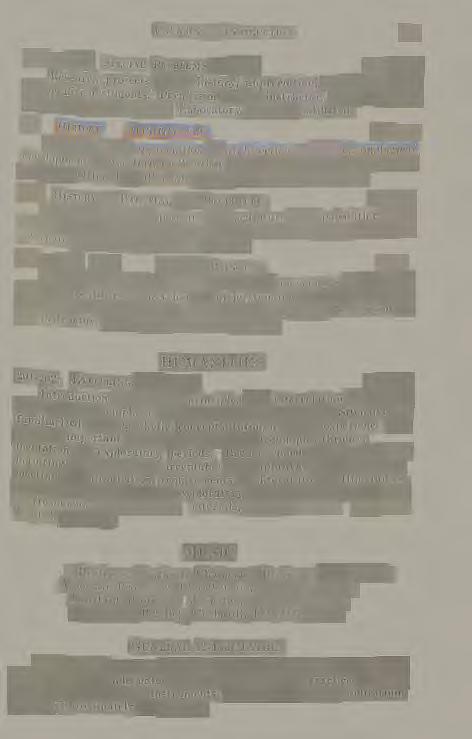
201-202. EXPLORING THE ARTS. 6 hour, . Introduction to the basic principles and interrelation of the creative arts with emphasis on music and the visual arts. Students arc familiarized with study of important aesthetic concepts through direct experience and works of art and with techniques through e.xpcrim.e~tation in exploratory periods. Recommended for students not maJoring in these fields· acceptable with approval of the advist>r a,; meeting the graduation' requirements in literature or Humanities. Three class periods and one exploratory period each week. Not open to freshmen. Cou,·se fee for materials, $2.nO a sc>inestcr. (S<'e also English 203-204).
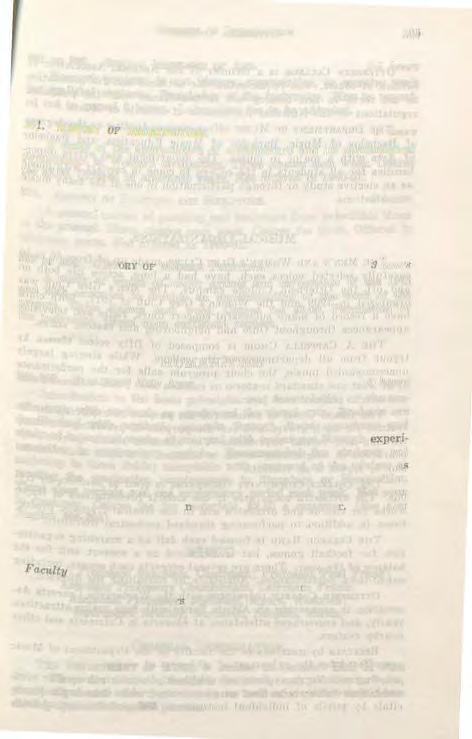
MUSIC
Facl(fty: Professor Shackson, Chairman; Professor Paul Frank: Associate Professors Chamberlain, Lawl'ence Frank; Assistant Professors Johnston, Myers, \\'esh·ich; Ins ructors Bradley, Gerhardt, Leupold, Smitl1.
GENERAL INFORMATION
THE DEPARTMEN'T OF MUSIC is located in Lambert Hall of Fme Arts. There are adequate facilities for study and practice in voice, Piano, organ and other instruments, as well as a recital auditorium s,ating approximately 250 persons.
10(i OTT!c'RBEI .. COLLEGE
OTIERBEIN COLLEGE is a member of the National Association of Schools of Music. The requirements for entrance and for graduation as set forth in this catalog are in accordance with the published regulations of the National Association of Schools of Music.
THE DEPAR'rMENT OF MUSIC offers courses leading to the degrees of Bachelor of Music, Bachelor of Music Education, and Bachelor of Arts with a major in music. The department also offers opportunities for all students in the college to come in contact with music as an elective study or through participation in one of the many music organizations.
MUSICAL ORGANIZATIONS
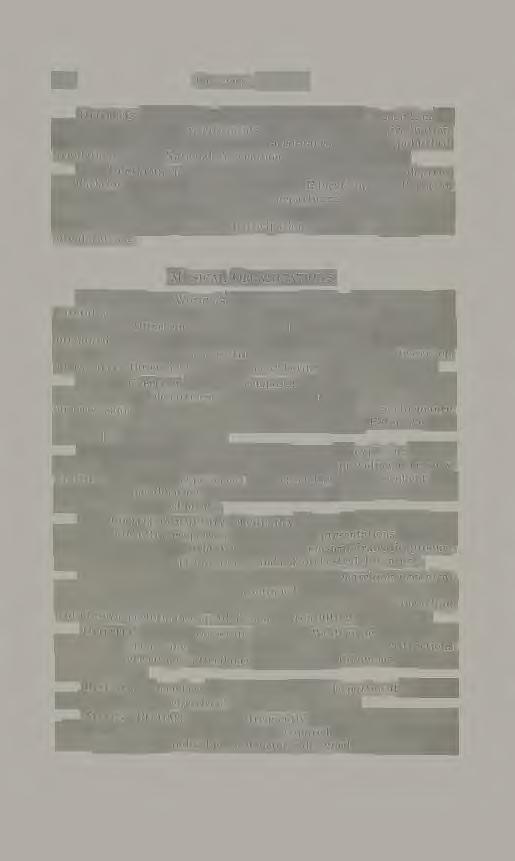
THE MEN'S AND WOMEN'S GLEE CLUBS, made up of from 36 to 50 carefully selrcted voices each, have had a long, active life both on and off the Otterbein College campus. The Men's Glee Club was organized in 1909 and the Women's Glee Club in 1917. Both clubs have a record of many successful concert tours, radio and television appearances throughout Ohio and neighboring and eastern states.
THE A CAPPELLA C11om is composed of fifty voices chosen by tryout from all departments of the college. While singing largely unaccompanied music, the choir program calls for the performance of at least one standard oratorio or cantata each year. Extensive concertizing is planned each year.
THE BRASS CHom is formed for the purpose of exploring the literature for such groups and for the purpose of providing necessary training and recital experience. The ensemble makes frequent appcuances in neighboring towns in addition to a short tour. Admission by tryout to all students.
TnE COLLEGE-COMMUNITY ORcm,;sTRA is open to students by tryout. The orchestra cooperates in the annual presentations of major works for chorus and orchestra and in the musical-dramatic productions, in addition to performing standard orchestral literature.
THE C0LLCGE BAND is formed each fall as a marching organization for football games, but is continued as a concert unit for the balance of the year. There are several concerts each season, including out-of-town performances. Admission by consulting the director.
OTTERBEIN COLLEGE cooperates with the ,vesterville Concerts Association in sponsoring an Artists Series with four major attractions yearly, and encourages attendance at conceli.s in Columbus and other nearby centers. RECITALS by members of the faculty of the Department of Music are offered for the enjoyment of all lovers of music. STUDE:-.;T RECITALS are given frequently to which the public is invited, and which students of music are required to attend. Studio recitals by pupils of individual instructors, designed for mutual criti-
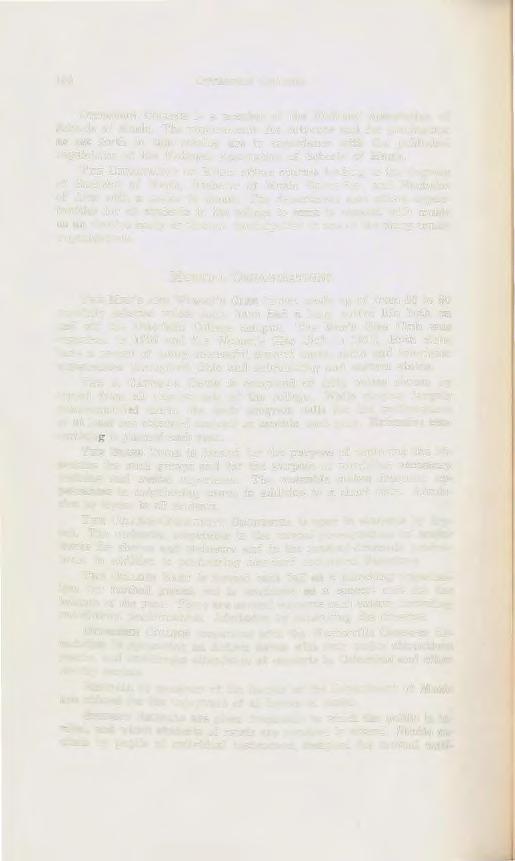

COURSES OF lNSTRUCTlON 107
cism and experience, are held from time to time. Students are expected to perform as their instructors direct, but should not appear in public performances without the consent of the instructo1·.
SPECIAL STUDENTS, not wishing to enter any of the courses leading to a degree, are not required to follow the presc1·ibed outlines, but are given systematic work in whatever musical subject they elect.
SCORES AND BOOKS RELATING TO MUSIC are found in the Centennial Library and in the depal'tmental 1ibrary. Students also have access to the faci1ities of the Westerville Public Libl'ary.
ENTRANCE REQUIREMENTS for degree courses al'e found on page 108. Private lessons in applied music, such as Piano, Violin, Voice. etc. may be had without foi-mal entrance upon any degree course, by consultation with the chainnan of the Department of Music.
Graduates of first-grade high schools are admitted to all degree courses, subject to satisfacto1·y audition in music.
REQUIREMENTS FOR DEGREE COURSES
GENERAL STATEMENT CONCERNING THE DEGREE OF BACHELOR OF MUSIC
The course of study with concentration in applied Music demands considerable talent in a particular medium of performance, general musicianship, and a capacity for intelligent practice. The goal toward which the student must work during all four yea1·s is the ultimate mastery of performance. The candidate for this degree must demonstrate adequate technique to produce an artistic performance. He should give evidence of tho1·ough prepai·ation in the theory and literature of music.
All degi-ee candidate~ in music must pass an examination each semester in their major and minor applied fields before a faculty jury. After satisfacto1·y ap1learances on student recitals during all four years, the Bachelor of Music candidate must give a full recital in his major applied subject during his last year. The required number of semester hours, one hundred twenty-four, must include at least ninety in music subjects. A ma.xhnum of thirtysix hours may be in academ-ic subjects. Students a1·e 1·equired to take a minimum of sixty miJmtes of individual instruction per week in the major subjects in applied 1nusic throughout each year of residence. One semester hour credit shall be given for each three hours per week of practice, plus the necessary individual instruction, but no more than six hours credit will be allowed for the major subject during one semester. At least twenty-four semester hours of the last thirty hours required for a deg1·ee shall be earned in residence.

BACHELOR OF Musrc, PIANOFORTE MAJOR .,
Entrance requirements and standards expected ce51ful for sue completion of the four-year course of study: t Note-It is understood that the following requirements are !f1 to be construed in any way as outlines or courses of study, but _me; at indicate the comparative degrees of advancement to be attame the various stages of the courses.
PIANO REQUIREMENTS
A. Requirements for Entrance Id
To enter the four-year degree course in piano, the studen~ sho:nd be_ grounded in reliab~e technique. He should play all ~aJo;hords mmor scales correctly m moderately rapid tempo, also broken in octave position in all keys and should have acquired SYst atic ero methods of practice. 5
He should have studjed some of the standard etude~, sut~ t~e Czerny, Op. 299, Book l; Heller, Op. 47 and 46 (according Bach individual needs of the pupil); Bach, Little Prelu~es; _a _fe; to-two-part Inventions and compositions corresponrung m d1fficu Y
Haydn, Sonata No. 11, G major No. 20 (Schirmer)·
Mozart, Sonata C Major No. 3, F major No. 13 (Schirm:i·). Beethoven, Variations on Nel cor Piu, Sonatas Op. 49, :No. 1 • OP· 14, Nos. 1 and 2. Schubert, Impromptu Op. 142, No. 2, etc. n. End of Second Year At the end of the second year the student should . d h acquire ave_ temPo a technique sufficient to play scales and arpeggios in rapidd •xtb to play scales in pa1·allel and contrary motion, in thirds an s~ecb a~d in various rhythms. He should have acquired some octa~~owin~ nique and i;hould have studied compositions of at least the fo grades of difficulty: Bach, easici: preludes and fugues from Well Tempered Cl vichOrd a Bach, French Suites and Partitas. No Beethoven, sonatas such as Op. 2, N 0 • 1; Op. 26; Op. 31 • ·
Compositions by various romantic and modern composers. 0 The_ student should demonstrate his ability to read at sight ace pamments and compositions of moderate difficulty.
C. End of Fourth Year , ' The candidate must have acquired the principles of tone P1 ' 00d tion and velocity and their application to scales, arpeggios! ~

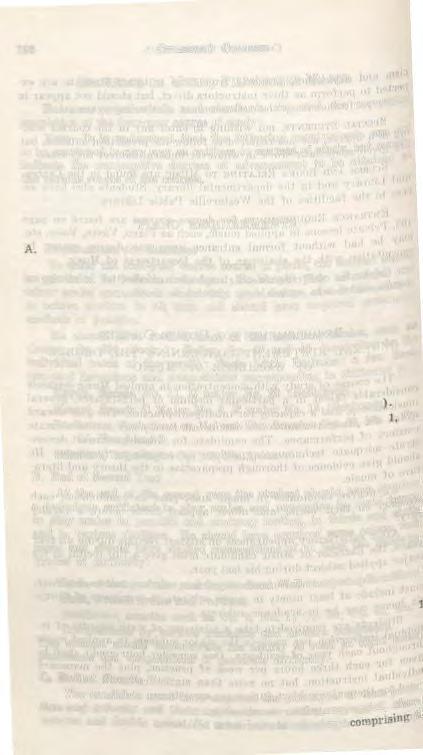
COURSES or INSTRUCTION 109
~:rincipal classic, :romantic, and modem compositions which should mclude such works as:
Bach, English Suites, toccatas, Well Tempered Clavichord.
Italian Concerto.
Beethoven, sonatas Op. 81, Nos. 2 & 3 and later e.""tcept Op. 49.
Compositions by Brahms, Chopin, Schumann and modern compcsers.
Concerti by Mozart, Beethoven. Candidates must have had considerable experience in ensemble and should be capable sight readers. .
BACHELOR OF MUSIC, VOCAL MAJOR

VOICE REQUIREMENTS A. Entrance Requirements
To enter the four-year degree course in voice the student should be able to sing on pitch with correct phrasing and musical intelligence standard songs in good English (the simpler classics ar~ recomrnende?) • He should also demonstnte his ability to read a simple song at sight and have a knowledge of the rudiments of music. • End of Second Year
At the end of the second year the student should have ac~~ed knowledge of breath control, tone quality, principles of enunc1abo~, n?. pronunciation as applied to singing. He should demon~trate his ~ihty to sing major, minor, and chromatic scales, arpeggios, ~erises for agility, for sustaining tone and the classic vocal embellishents. He should demonstrate a kn~wledge of early Italian classics, nd the ability to sing one or more of the less exacting arias o! opera nd oratorio. He should also have acquired use of one language in ddition to English. · End of Fourth Year . 1:he candidate for graduation should demonstrate the ability to :mg m three foreign languages, a lmowledge of recitative in both the ree and measured forms, knowledge of the general song literature and the ability to give a creditable recital. The repertory for immediate use should consist of at least four operatic arias, four oratorio arias, twenty classic, and twenty standard modern songs. . :he candidate should have completed two years of ensemble si_nging; he must also have completed sufficient piano study to enable him to plar accompaniments of averaA"e difficulty.
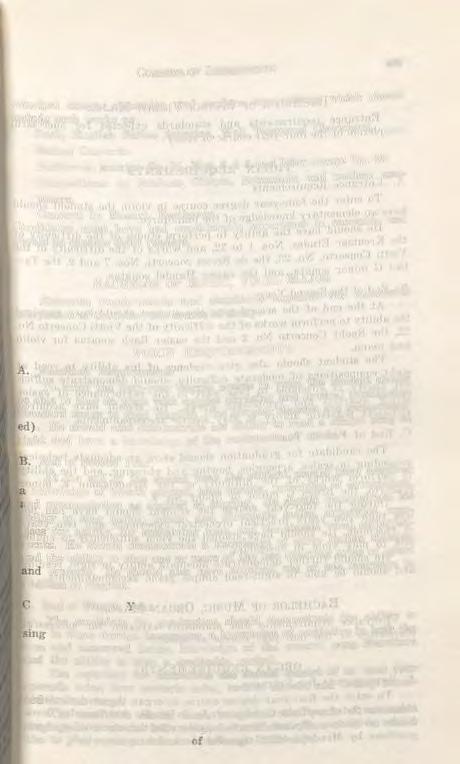
110
OTTERBEIN COLLEGE
BACHELOR OF MUSIC, VIOLIN MAJOR
Entrance requirements and standards expected for successful completion of the four-year course of study:
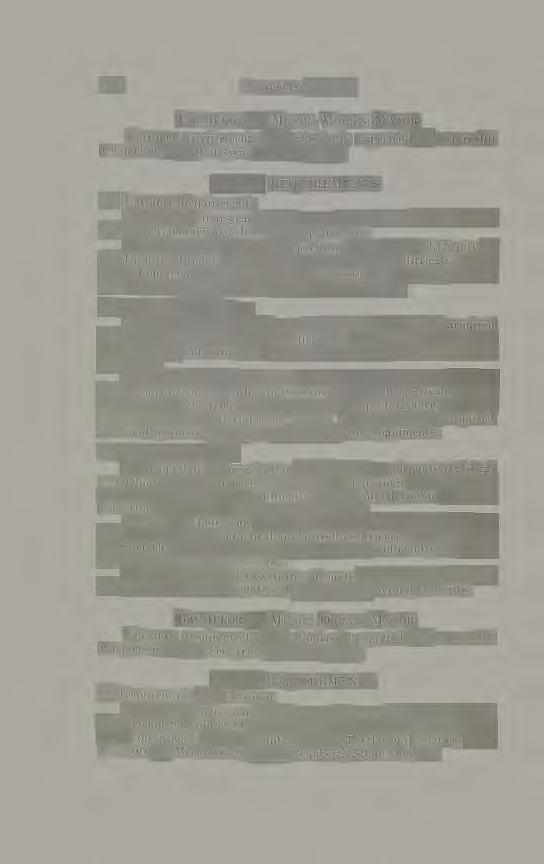
VIOLIN REQUIREMENTS :\. Entrance Requirements
To enter the four-year degree course in violin the student should have an elementary knowledge of the pianoforte.
He should have the ability to perform etudes of the difficulty of the Kreutzer Etudes, Nos. 1 to 32, and works of the difficulty of the Viotti Concerto, No. 23, the de Beriot concerti, Nos. 7 and 9, the Tartini G minor sonata, and the easier Handel sonatas. B. End of the Second Year
At the end of the second year the student should have acquired the ability to perform works of the difficulty of the Viotti Concerto No. 22, the Spohr Concerto No. 2 and the easier Bach sonatas for violin and piano.
The student shoula .. }so give evidence of his ability to read at sight compositions of moderate difficulty, should demonstrate sufficient ability in ensemble to take part in the performance of easier string quartets and symphonic works. He should have acquired sufficient pianistic ability to play simple accompaniments. C. End of Fourth Year
Tbe candidate for graduation should show an adequate technical grounding in scales, arpeggios, bowing and phrasing, and the ability to perform works of the difficulty of the Mendelssohn E minor concerto, the Bruch G minor or Spohr No. 8.
During the four-year course the student should have had not less than two years practical orchestral experience and two years of ensemble. He should have studied the viola sufficiently to enable him to play viola in ensembles.
He should further demonstrate adequate ability in sight 1·eading and should be able to sight-read simple piano accompaniments.

BACHELOR OF Music, ORGAN MAJOR
Entrance requirements and standards expected for successful completion of the four-year course of study:
ORGAN REQUIREMENTS A. Requi1·ernents for Entrance
To enter the four-year degree course in organ the student should have completed sufficient piano study to enable him to play some Bach inventions, Mozart sonatas, easier Beethoven sonatas, compositions by Mendelssohn, Grieg, Schubert, Schumann, etc.
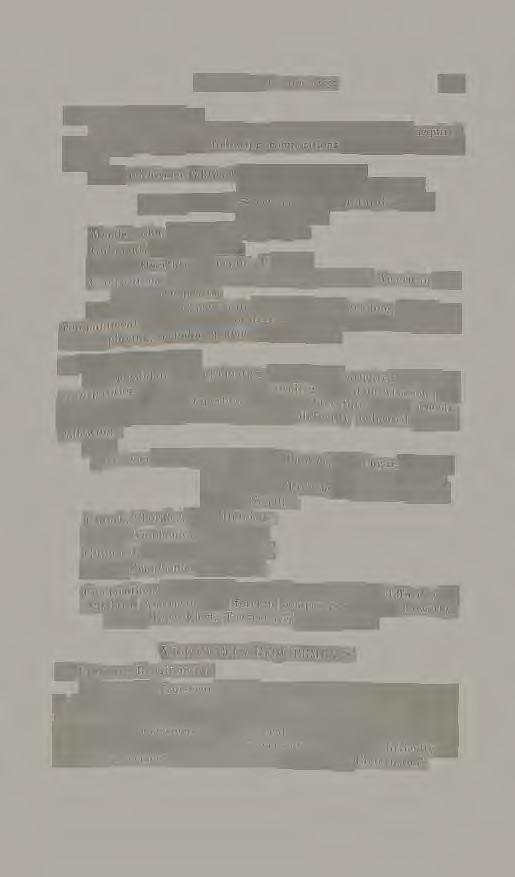
COURSES OF INSTRUCTION 111
B. End of Second Year At the end of the second year the student should have acquired the ability to play the following compositions or others of similar grade: Bach (Schirmer Edition) Vol. I, No.12, Prelude. Vol. II, No. 17, Fugue in G minor. (Ditson Edition) Selections from the Liturgical Year Organ Chorals.
Mendelssohn, Sonatas Nos. II, IV, V.
Guilmant, Sonata No. IV.
Hollins, Overtures C rnajor-C minor.
Compositions for the modern organ by standard American and foreign composers. H hould also demonstrate ability in es · t. d companiment of the ~Jass1~ ~ra a~ sight reading, in the acd · lrr;.asses, an m geneml service playing, includmg p aymg m e c e s.
C. End of Fourth Year
The candidate_ for graduation shoul? have acquired ability in Otransp Id sition at sight, open score readmg and improvisation He t f · · }lave a large reper ory o organ literature of all schools shou cJaSSI ·c and modern, of the degree of difficulty indicated by th; following:
Bach (Schirmer Edition) Vol. IV, ~o. 4, Fantasia and Fugue, G minor. Vol. IV, No. 7, Prelude and Fugue, B minor. Vol. II, No. 12, Prelude and Fugue, D major. Book V, Sonatas.
Franck, Chorales, Piece Heroique.
Widor, Symphonies Nos. V to X.
Guilmant, Sonata D minor, No. 1.
Vierne, Symphonies Nos. I to V.
Compositions for modern organ of same grade of difficulty by standard American and foreign composers, such as Sowerby, Reger, Karg-Elel't, Tournemire, Dupre, Liszt.
VIOLONCELLO REQUIREMENTS A. Entrance Requirements
To enter the four-year degree course in 'cello, the student should be able to play all major and minor scales in three octaves and an etude by Duport or Merk. He should also be able to play one slow and one fast movement of a classical sonata, such as the one by Corelli in D Minor and a fast movement of the same difficulty as the first movement of the Concerto in B Minor by Goltermann.


112
OTTERBEIN COLLEGEl
B. End of Second Year
At the end of the second year, the student should have acquired adequate technique to play all major and minor scales and arpeggios in four octaves at a rapid tempo as well as scales in octaves, thirds and sixths in two octaves.
The student should have studied compositions of the same difficulty as the St. Saens Concerto, easier movements from the Bach Suites for Cello alone and the Sonata in G Major by Sammartini.
Knowledge of the ensemble literature including the easier trios and quartets by Beethoven, Brahms, Haydn, and Mozart should be attained by the end of the second year. The student must have acquired the ability to read ensemble and orchestra parts of moderate difficulty at sight, and to play simple piano accompaniments. C. End of Fourth Year
The candidate for graduation must be able to play all major and minor scales and arpeggios in four octaves at a rapid tempo with various bowings. He must be able to play at a moderate tempo, scales in octaves, thirds and sixths in three octaves.
The student should have in his repertory, two of the Beethoven, one of the Brahms sonatas for cello and piano, an American composition in large form, a concerto of the same difficulty as the Lalo concerto and a number of pieces such as: "At the Fountain" by Davidoff and the "Spinning Song" by Popper.
The candidate's playing knowledge of tl1e ensemble 1ite1·ature will include the classics and the moderns. He must not only be able to play a program very well by memory, but he must also be able t-0 demonstrate that he has enough ensemble and orchestral experience to put him in tlie professional class. He should be able to sight read simple piano accompaniments.
CLARINET REQUlREMENTS A. Entrance Requirements
He should have acquired the fundamentals of good tone production, breath control and hand position; an elementary h-nowledge of major and minor scales and arpeggios; and the ability to perform material such as is contained in the Langenus Clarinet Method, Part I. He should have studied one or more solo numbers of good musical quality not too difficult for him to play well. B. End of Second Year
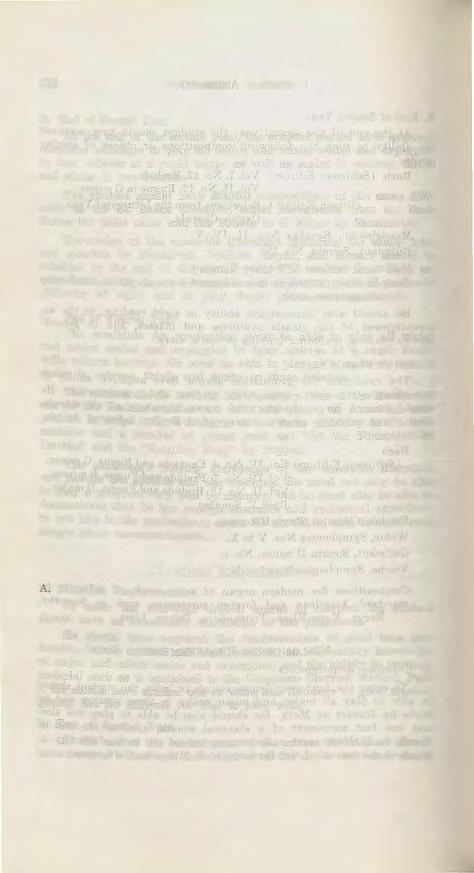
COt,'RSF-5 OF INSTRUCTION 113
and arpeggios; have studied the etudes of Rose and the earlier books of Jean-Jean; have acquired the ability to perform well works of the difficulty of the Spohr Concerto No. 1, the Weber Concerto No. 1 and Grand Duo Concertante and the Saint-Saens Sonata.
The student should also give evidence of hls ability to read at sight compositions of moderate difficulty, and should demonstrate sufficient ability to take part in the performance of easier ensemble numbers and hold the second clarinet chair in symphonic works. He should have acquired sufficient pianistic ability to play simple &ecompaniments.
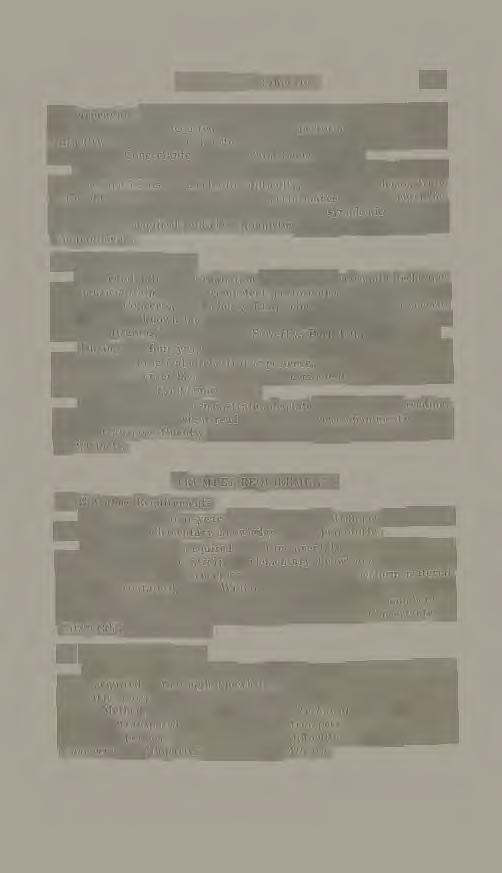
C. End of Fourth Year
The candidate for graduation should show adequate technique and musicianship for the competent performance of such works as the Mozart Concerto, the Debussy Rhapsodie and the Weber Concerto No. 2; also a knowledge of such sonatas for clarinet and piano as those by Brahms, Reger, Mason, Sowerby, Bernstein, and Tuthill.
During the four-year course the student should have at least two full years of practical orchestral experience, two years of band and two years of ensemble. He sr.ould be competent to hold the first clarinet chair in symphonic works.
He should further demonstrate adequate ability in sight reading. He should be able to sight-read simple piano accompaniments and be able to transpose fluently on the Bb clarinet parts written for C and A clarinets.
TRUMPET REQUIREMENTS A. Entrance Requirements
To enter the four-year degree course in trumpet the student should have an elementary knowledge of the pianoforte.
He should have acquired the fundamentals of good tone production and breath control; an elementary knowledge of all major and minor scales and arpeggios; and the ability to perform material such as is contained in the Williams method, Part II or Lillya, Book II or the like. He should have studied one or more solo numbers of good musical quality such as Balay, Petite Piece Concertante or Fitzgerald, Modern Suite.

n. End of Second Year
At the end of the second year of the course the student should have acquired a thorough knowledge of all major and minor scales and arpeggios; have studied such etudes as may be found in the Arban Method, Gatti, Part II or Petit, 15 Teclmical Etudes, as written and also transposed as for C and A trumpets; have acquired the ability to perform well works of the difficulty of Balay, Piece de Concours and Ropartz, Andant~ and Allegro.
114
OTTERBEIN COLLEGE
The student should also give evidence of bis ability to read at sight compositions of moderate difficulty, and should demonstrate sufficient ability to hold second chair in the performance of works for orchestra and band. He should have acquired sufficient pianistic ability to play simple accompaniments.

C. End of Fourth Year
The candidate for graduation should show adequate technique and musicianship for the competent performance of such works as the Hayden and Giannini concertos, the Fitzgerald Concerto in A flat and the Vidal Concertino and the sonatas of Hindemith and Sowerby.
During the four-year course the student should have had four full years of orchestral and band experience and be able to transpose and play readily parts written for trumpets in all keys. He should be competent to hold first chair in orchestra and band, and be able to read at sight with facility. He should also be able to read simple piano accompaniments at sight.











